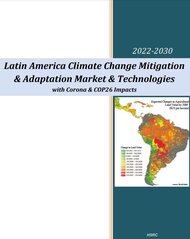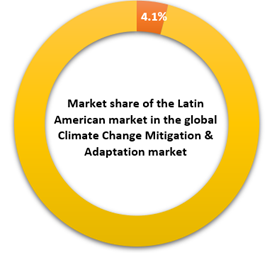Download TOC as PDFContents
1 The Report Key Assumptions…………………………………. 46
2 Executive Summary………………………………………………. 47
2.1 Key Findings…………………………………………………… 47
2.2 Key Conclusions………………………………………………. 60
2.3 Latin America Climate Change Mitigation Market Segmentation Vectors……………………………………….. 70
2.4 Latin America Climate Change Mitigation Market – 2022-2030……………………………………………………………… 71
2.4.1 Latin America Market by Technology – 2022-2030 71
2.4.2 Latin America Market by Sector – 2022-2030……. 73
2.4.3 Latin America Market by Revenue Source – 2022-2030………………………………………………………… 74
2.4.4 Latin America Market by Region – 2022-2030…… 74
2.4.5 Latin America Market by Country – 2022-2030….. 76
3 COP26 & COVID-19 Implications……………………………… 77
3.1 COP26 Takeaway……………………………………………. 77
3.2 COVID-19 Implications………………………………………. 78
4 The Industry Value Chain……………………………………….. 80
5 Business Opportunities…………………………………………. 81
6 Market Drivers………………………………………………………. 92
7 Market Inhibitors…………………………………………………… 93
8 SWOT Analysis…………………………………………………….. 94
8.1 Strengths……………………………………………………….. 94
8.2 Weaknesses…………………………………………………… 95
8.3 Opportunities…………………………………………………… 96
8.4 Threats………………………………………………………….. 97
TECHNOLOGY, PRODUCT & SERVICE MARKETS…………….. 99
9 Latin America Climate Change Mitigation Technologies, Products & Services Markets – 2020-2030………………… 99
9.1 Technology, Products & Services Markets Size………. 99
9.2 Technology Products & Services Markets Dynamics. 100
9.3 Technology Products & Services Markets Share……. 102
10 Air Sourced Heat Pumps Market – 2022-2030…………… 104
10.1 CEO Takeaway……………………………………………… 104
10.1.1 Summary………………………………………………… 104
10.1.2 Heat Pump Technologies……………………………. 110
10.1.3 Heat Pump Cost Performance……………………… 111
10.1.4 Legislation……………………………………………….. 112
10.2 Key Vendors………………………………………………….. 112
10.3 Latin America Air Sourced Heat Pumps Market – 2020-2030……………………………………………………………. 113
10.3.1 Air Sourced Heat Pumps Market Size……………. 113
10.3.2 Air Sourced Heat Pumps Market Dynamics…….. 113
10.3.3 Air Sourced Heat Pumps Market Share………….. 113
11 Big Data & AI Market – 2022-2030…………………………… 114
11.1 CEO Takeaway……………………………………………… 114
11.1.1 Summary………………………………………………… 114
11.1.2 Application of Artificial Intelligence (AI) in the Latin America Warming Mitigation Industry…………….. 117
11.2 Key Vendors………………………………………………….. 117
11.3 Latin America Big Data & AI Market – 2020-2030….. 118
11.3.1 Big Data & AI Market Size…………………………… 118
11.3.2 Big Data & AI Market Dynamics……………………. 119
11.3.3 Big Data & AI Market Share…………………………. 119
12 Bioenergy Market – 2022-2030………………………………. 120
12.1 CEO Takeaway……………………………………………… 120
12.1.1 Summary………………………………………………… 120
12.1.2 Bioenergy for Electricity Generation………………. 123
12.1.3 Bioenergy in Industry…………………………………. 123
12.1.4 Thermo-Chemical Process………………………….. 124
12.1.5 Bio-Chemical Process………………………………… 125
12.1.6 Bioenergy Conversion Technologies……………… 126
12.1.7 Latin America Bioenergy Market…………………… 127
12.1.8 Latin America Bio-Heating Market…………………. 127
12.1.9 Biomass Heating For Buildings…………………….. 128
12.1.10 Latin America Bio-Power Markets…………………. 129
12.1.11 The Latin America Solid Biomass Industry………. 130
12.1.12 The Latin America Liquid Biofuels Industry……… 131
12.1.13 The Latin America Gaseous Biomass Industry…. 131
12.1.14 Latin America Bioenergy CCS & CCU……………. 131
12.1.15 Thermal Conversions…………………………………. 133
12.1.16 Chemical Conversion…………………………………. 133
12.1.17 Biochemical Conversion……………………………… 133
12.1.18 Electrochemical Conversions……………………….. 134
12.2 Key Vendors………………………………………………….. 134
12.3 Latin America Bioenergy Market – 2020-2030………. 135
12.3.1 Bioenergy Market Size……………………………….. 135
12.3.2 Bioenergy Market Dynamics………………………… 135
12.3.3 Bioenergy Market Share……………………………… 135
13 Biological Carbon Capture & Sequestration Market – 2022-2030…………………………………………………………… 136
13.1 CEO Takeaway……………………………………………… 136
13.1.1 Summary………………………………………………… 136
13.1.2 Kelp Farms Products…………………………………. 138
13.1.3 Biological Carbon Sequestration…………………… 138
13.1.4 Microalgae Carbon Biological Capture & Utilization……………………………………………………………… 138
13.1.5 Oceans Carbon Sequestration……………………… 139
13.1.6 Soil Carbon Sequestration…………………………… 139
13.1.7 Forests Carbon Sequestration……………………… 139
13.1.8 Grasslands Carbon Sequestration………………… 140
13.1.9 Impacts of Carbon Sequestration………………….. 140
13.2 Latin America Biological Carbon Capture & Sequestration Market – 2020-2030…………………….. 140
13.2.1 Biological Carbon Capture & Sequestration Market Size……………………………………………………….. 140
13.2.2 Biological Carbon Capture & Sequestration Market Dynamics………………………………………………… 141
13.2.3 Biological Carbon Capture & Sequestration Market Share……………………………………………………… 141
14 Bioremediation Market – 2022-2030……………………….. 142
14.1 CEO Takeaway……………………………………………… 142
14.1.1 Summary………………………………………………… 142
14.1.2 Bioremediation Cleanup Strategy………………….. 146
14.2 Key Vendors………………………………………………….. 149
14.3 Latin America Bioremediation Market – 2020-2030… 151
14.3.1 Bioremediation Market Size…………………………. 151
14.3.2 Bioremediation Market Dynamics………………….. 151
14.3.3 Bioremediation Market Share………………………. 151
15 Carbon Capture & Storage Market – 2022-2030………… 152
15.1 CEO Takeaway……………………………………………… 152
15.1.1 Summary………………………………………………… 152
15.1.2 Geological Carbon Sequestration…………………. 154
15.1.3 Technological Carbon Sequestration……………… 154
15.1.4 Graphene Production…………………………………. 154
15.1.5 Direct Air Capture (DAC)…………………………….. 154
15.1.6 Engineered Molecules………………………………… 154
15.1.7 CCS, DOE Investments………………………………. 155
15.2 Key Vendors………………………………………………….. 156
15.3 Latin America Carbon Capture & Storage Market – 2020-2030…………………………………………………….. 157
15.3.1 Carbon Capture & Storage Market Size…………. 157
15.3.2 Carbon Capture & Storage Market Dynamics….. 157
15.3.3 Carbon Capture & Storage Market Share……….. 158
16 Carbon Capture & Utilization Market – 2022-2030…….. 159
16.1 CEO Takeaway……………………………………………… 159
16.1.1 Summary………………………………………………… 159
16.1.2 CCU Proliferation………………………………………. 161
16.1.3 Carbon Capture and Utilization Applications……. 162
16.1.4 Algae Cultivation……………………………………….. 163
16.2 Key Vendors………………………………………………….. 165
16.3 Latin America Carbon Capture & Utilization Market – 2020-2030…………………………………………………….. 166
16.3.1 Carbon Capture & Utilization Market Size……….. 166
16.3.2 Carbon Capture & Utilization Market Dynamics… 166
16.3.3 Carbon Capture & Utilization Market Share…….. 166
17 Climate Adapted Agriculture Market – 2022-2030……… 167
17.1 CEO Takeaway……………………………………………… 167
17.1.1 Summary………………………………………………… 167
17.2 Agriculture GHG Emission………………………………… 171
17.3 Key Vendors………………………………………………….. 173
18.1 Latin America Climate Adapted Agriculture Market – 2020-2030…………………………………………………….. 174
18.1.1 Climate Adapted Agriculture Market Size……….. 174
18.1.2 Climate Adapted Agriculture Market Dynamics… 174
18.1.3 Climate Adapted Agriculture Market Share……… 174
19 Climate Adapted Water Infrastructure Market – 2022-2030 175
19.1 CEO Takeaway……………………………………………… 175
19.1.1 Summary………………………………………………… 175
19.1.2 Digital Technologies…………………………………… 183
19.1.3 Water Management Strategy……………………….. 184
19.1.4 Agriculture Water Management……………………. 188
19.1.5 Urban Water Management………………………….. 189
19.1.6 Urban Decision Support System…………………… 190
19.2 Key Vendors………………………………………………….. 190
19.3 Latin America Climate Adapted Water Infrastructure Market – 2020-2030………………………………………… 192
19.3.1 Climate Adapted Water Infrastructure Market Size……………………………………………………………… 192
19.3.2 Climate Adapted Water Infrastructure Market Dynamics………………………………………………… 192
19.3.3 Climate Adapted Water Infrastructure Market Share……………………………………………………………… 193
20 Compressed-Air Storage Market – 2022-2030………….. 195
20.1 CEO Takeaway……………………………………………… 195
20.1.1 Summary………………………………………………… 195
20.1.2 Adiabatic Compressed-Air Energy Storage……… 197
20.1.3 Diabatic Compressed-Air Energy Storage………. 197
20.2 Key Vendors………………………………………………….. 198
20.3 Latin America Compressed-Air Storage Market – 2020-2030……………………………………………………………. 198
20.3.1 Compressed-Air Storage Market Size……………. 198
20.3.2 Compressed-Air Storage Market Dynamics…….. 199
20.3.3 Compressed-Air Storage Market Share………….. 199
21 Concentrating Solar Power (CSP) Market – 2022-2030. 200
21.1 CEO Takeaway……………………………………………… 200
21.1.1 Summary………………………………………………… 200
21.1.2 CSP Projects……………………………………………. 202
21.1.3 CSP vs. Solar PV……………………………………… 203
21.2 CSP Key Vendors…………………………………………… 203
21.3 Latin America Concentrating Solar Power (CSP) Market – 2020-2030………………………………………………….. 204
21.3.1 Concentrating Solar Power (CSP) Market Size… 204
21.3.2 Concentrating Solar Power (CSP) Market Dynamics……………………………………………………………… 205
21.3.3 Concentrating Solar Power (CSP) Market Share. 205
22 Cybersecurity Market – 2022-2030…………………………. 206
22.1 CEO Takeaway……………………………………………… 206
22.1.1 Summary………………………………………………… 206
22.1.2 Cybersecurity in the Latin America Warming Mitigation Industry…………………………………….. 208
22.1.3 Cybercrime in the Electric Power Industry………. 208
22.2 Key Vendors………………………………………………….. 209
22.3 Latin America Cybersecurity Market – 2020-2030….. 210
22.3.1 Cybersecurity Market Size…………………………… 210
22.3.2 Cybersecurity Market Dynamics…………………… 210
22.3.3 Cybersecurity Market Share………………………… 210
23 Desalination Plants Market – 2022-2030………………….. 211
23.1 CEO Takeaway……………………………………………… 211
23.2 Technologies…………………………………………………. 215
23.2.1 Solar Distillation………………………………………… 216
23.2.2 Natural Evaporation…………………………………… 216
23.2.3 Vacuum Distillation……………………………………. 216
23.2.4 Multi-Stage Flash Distillation……………………….. 216
23.2.5 Multiple-Effect Distillation……………………………. 216
23.2.6 Vapor-Compression Distillation…………………….. 217
23.2.7 Wave-Powered Desalination……………………….. 217
23.2.8 Membrane Distillation………………………………… 217
23.2.9 Reverse Osmosis……………………………………… 217
23.2.10 Forward Osmosis……………………………………… 218
23.2.11 Freeze–Thaw…………………………………………… 218
23.2.12 Electrodialysis Membrane…………………………… 219
23.2.13 Technical Challenges…………………………………. 219
23.3 Key Vendors………………………………………………….. 220
23.4 Latin America Desalination Plants Market – 2020-2030 221
23.4.1 Desalination Plants Market Size…………………… 221
23.4.2 Desalination Plants Market Dynamics……………. 222
23.4.3 Desalination Plants Market Share…………………. 222
24 Direct Geothermal Heating & Cooling Market – 2022-2030 223
24.1 CEO Takeaway……………………………………………… 223
24.1.1 Summary………………………………………………… 223
24.1.2 Direct Geothermal Heating & Cooling Applications……………………………………………………………… 224
24.1.3 Geothermal Heat Pumps. Heating and Cooling… 224
24.1.4 Geothermal District Heating…………………………. 225
24.1.5 Geothermal Heating Pump Price Competitiveness……………………………………………………………… 226
24.2 Latin America Direct Geothermal Heating & Cooling Market – 2020-2030………………………………………… 227
24.2.1 Direct Geothermal Heating & Cooling Market Size……………………………………………………………… 227
24.2.2 Direct Geothermal Heating & Cooling Market Dynamics………………………………………………… 228
24.2.3 Direct Geothermal Heating & Cooling Market Share……………………………………………………………… 228
25 Direct Solar Water Heating Market – 2022-2030………… 229
25.1 CEO Takeaway……………………………………………… 229
25.1.1 Summary………………………………………………… 229
25.2 Key Vendors………………………………………………….. 233
25.3 Latin America Direct Solar Water Heating Market – 2020-2030…………………………………………………….. 233
25.3.1 Direct Solar Water Heating Market Size…………. 233
25.3.2 Direct Solar Water Heating Market Dynamics….. 234
25.3.3 Direct Solar Water Heating Market Share……….. 234
26 Electric Buses Market – 2022-2030…………………………. 235
26.1 CEO Takeaway……………………………………………… 235
26.1.1 Summary………………………………………………… 235
26.1.2 E-Bus Economy………………………………………… 237
26.1.3 COVID-19 Effects……………………………………… 239
26.2 Key Vendors………………………………………………….. 239
26.4 Latin America Electric Buses Market – 2020-2030…. 240
26.4.1 Electric Buses Market Size………………………….. 240
26.4.2 Electric Buses Market Dynamics…………………… 240
26.4.3 Electric Buses Market Share……………………….. 240
27 Energy-Efficient Air Conditioning & Refrigeration (ACR) Market – 2022-2030………………………………………………. 241
27.1 CEO Takeaway……………………………………………… 241
27.1.1 Summary………………………………………………… 241
27.1.2 Example 1. Thermoelectric Effect…………………. 244
27.1.3 Example 2: Reciprocating Compressors…………. 245
27.1.4 Example 3: Energy Efficient HVAC Ducts……….. 246
27.2 Key Vendors………………………………………………….. 247
27.3 Latin America Energy-Efficient Air Conditioning & Refrigeration (ACR) Market – 2020-2030……………… 247
27.3.1 Energy-Efficient Air Conditioning & Refrigeration (ACR) Market Size…………………………………….. 247
27.3.2 Energy-Efficient Air Conditioning & Refrigeration (ACR) Market Dynamics……………………………… 247
27.3.3 Energy-Efficient Air Conditioning & Refrigeration (ACR) Market Share………………………………….. 248
28 Energy-Efficient Electric Appliances (w/o ACR) Market – 2022-2030…………………………………………………………… 249
28.1 CEO Takeaway……………………………………………… 249
28.1.1 Summary………………………………………………… 249
28.2 Key Vendors………………………………………………….. 253
28.3 Latin America Energy-Efficient Electric Appliances (w/o ACR) Market – 2020-2030………………………………… 253
28.3.1 Energy-Efficient Electric Appliances (w/o ACR) Market Size……………………………………………… 253
28.3.2 Energy-Efficient Electric Appliances (w/o ACR) Market Dynamics………………………………………. 254
28.3.3 Energy-Efficient Electric Appliances (w/o ACR) Market Share……………………………………………. 254
29 EV Charging Systems Market – 2022-2030………………. 255
29.1 CEO Takeaway……………………………………………… 255
29.1.1 Summary………………………………………………… 255
29.1.2 Light-Duty Vehicle Chargers………………………… 258
29.1.3 Private Home And Workplace Chargers…………. 259
29.1.4 Charging Heavy-Duty Electric Trucks…………….. 260
29.1.5 Mega-High Power Charging Standarts…………… 260
29.1.6 EVs and Energy Storage…………………………….. 261
29.1.7 Wireless Charging…………………………………….. 262
29.2 Key Vendors………………………………………………….. 263
29.3 Latin America EV Charging Systems Market – 2020-2030……………………………………………………………. 263
29.3.1 EV Charging Systems Market Size……………….. 263
29.3.2 EV Charging Systems Market Dynamics………… 264
29.3.3 EV Charging Systems Market Share……………… 264
30 Extreme Weather Public Warning Systems Market – 2022-2030…………………………………………………………………… 265
30.1 CEO Takeaway……………………………………………… 265
30.1.1 Summary………………………………………………… 265
30.1.2 Cell Baed Broadcast………………………………….. 269
30.1.3 Location Based Alert SMS…………………………… 271
30.2 Latin America Extreme Weather Public Warning Systems Market – 2020-2030……………………………. 273
30.2.1 Extreme Weather Public Warning Systems Market Size……………………………………………………….. 273
30.2.2 Extreme Weather Public Warning Systems Market Dynamics………………………………………………… 274
30.2.3 Extreme Weather Public Warning Systems Market Share……………………………………………………… 274
31 Flood Control Market – 2022-2030………………………….. 275
31.1 CEO Takeaway……………………………………………… 275
31.1.1 Summary………………………………………………… 275
31.1.2 Structural Forms of Mitigation………………………. 278
31.1.3 Nonstructural Measures……………………………… 279
31.1.4 Floodwater Diversion and Storage………………… 279
31.1.5 Floodplain and Stream Restoration……………….. 279
31.2 Key Vendors………………………………………………….. 279
31.3 Latin America Floods Control Market – 2020-2030…. 280
31.3.1 Floods Control Market Size…………………………. 280
31.3.2 Floods Control Market Dynamics………………….. 281
31.3.3 Floods Control Market Share……………………….. 281
32 Freight BEVs Market – 2022-2030…………………………… 282
32.1 CEO Takeaway……………………………………………… 282
32.1.1 Summary………………………………………………… 282
32.1.2 COVID-19 Effects……………………………………… 283
32.2 Key Vendors………………………………………………….. 284
32.3 Latin America Freight BEVs Market – 2020-2030…… 284
32.3.1 Freight BEVs Market Size…………………………… 284
32.3.2 Freight BEVs Market Dynamics……………………. 285
32.3.3 Freight BEVs Market Share…………………………. 285
33 GHG Emission Tracking Market – 2022-2030…………… 286
33.1 CEO Takeaway……………………………………………… 286
33.1.1 Summary………………………………………………… 286
33.1.2 Methane Emission Tracking Technologies………. 290
33.2 Key Vendors………………………………………………….. 292
33.3 Latin America GHG Emission Tracking Market – 2020-2030……………………………………………………………. 292
33.3.1 GHG Emission Tracking Market Size…………….. 292
33.3.2 GHG Emission Tracking Market Dynamics……… 293
33.3.3 GHG Emission Tracking Market Share…………… 293
34 Geothermal Power Generation Market – 2022-2030…… 294
34.1 CEO Takeaway……………………………………………… 294
34.1.1 Summary………………………………………………… 294
34.1.2 Geothermal Electric Power Generation………….. 296
34.1.3 Geothermal Power Plants LCOE…………………… 297
34.1.4 Enhanced Geothermal Systems (EGS)………….. 297
34.1.5 The 2022-2030 Market Growth Drivers…………… 299
34.2 Key Vendors………………………………………………….. 300
34.3 Latin America Geothermal Power Generation Market – 2020-2030…………………………………………………….. 301
34.3.1 Geothermal Power Generation Market Size…….. 301
34.3.2 Geothermal Power Generation Market Dynamics 301
34.3.3 Geothermal Power Generation Market Share….. 302
35 Green Cement Market – 2022-2030…………………………. 303
35.1 CEO Takeaway……………………………………………… 303
35.1.1 Summary………………………………………………… 303
35.1.2 Cement Decarbonization Options…………………. 307
35.1.3 Cement Negative Emission Technologies……….. 307
35.2 Key Vendors………………………………………………….. 309
35.3 Latin America Green Cement Market – 2020-2030…. 309
35.3.1 Green Cement Market Size…………………………. 309
35.3.2 Green Cement Market Dynamics………………….. 309
35.3.3 Green Cement Market Share……………………….. 310
36 Green Hydrogen Production Market – 2022-2030……… 311
36.1 CEO Takeaway……………………………………………… 311
36.1.1 Summary………………………………………………… 311
36.1.2 Green Hydrogen……………………………………….. 315
36.1.3 The European Hydrogen Market………………….. 316
36.1.4 The Asia-Pacific Hydrogen Market………………… 316
36.2 A Net-Zero“Hydrogen Economy” by 2050 Scenario… 317
36.3 Key Vendors………………………………………………….. 318
36.4 Latin America Green Hydrogen Production Market – 2020-2030…………………………………………………….. 319
36.4.1 Green Hydrogen Production Market Size……….. 319
36.4.2 Green Hydrogen Production Market Dynamics… 319
36.4.3 Green Hydrogen Production Market Share……… 319
37 Green Steel Market – 2022-2030…………………………….. 320
37.1 CEO Takeaway……………………………………………… 320
37.1.1 Summary………………………………………………… 320
37.1.2 CHG Emissions & Decarbonized (Green) Steel.. 322
37.2 Latin America Green Steel Market – 2020-2030…….. 323
37.2.1 Green Steel Market Size…………………………….. 323
37.2.2 Green Steel Market Dynamics……………………… 324
37.2.3 Green Steel Market Share…………………………… 324
38 Grid Modernization Market – 2022-2030………………….. 325
38.1 CEO Takeaway……………………………………………… 325
38.1.1 Summary………………………………………………… 325
38.1.2 Smart Grid………………………………………………. 327
38.1.3 Transmission Lines Modernization………………… 328
38.1.4 Demand Response……………………………………. 329
38.1.5 Hardening the Grid……………………………………. 329
38.1.6 Advanced Distribution Management Systems….. 330
38.1.7 Smart Inverters…………………………………………. 330
38.1.8 Smart Meters……………………………………………. 330
38.1.9 Microgrids……………………………………………….. 330
38.2 Latin America Grid Modernization Market – 2020-2030 332
38.2.1 Grid Modernization Market Size……………………. 332
38.2.2 Grid Modernization Market Dynamics…………….. 333
38.2.3 Grid Modernization Market Share…………………. 333
39 Grid-Scale Battery Storage Market – 2022-2030……….. 334
39.1 CEO Takeaway……………………………………………… 334
39.1.1 Summary………………………………………………… 334
39.1.2 The U.S. Energy Storage Market…………………. 337
39.1.3 Grid-Scale Battery Storage Benefits………………. 337
39.1.4 EVs and Energy Storage…………………………….. 338
39.2 Key Vendors………………………………………………….. 340
39.3 Latin America Grid-Scale Battery Storage Market – 2020-2030…………………………………………………….. 340
39.3.1 Grid-Scale Battery Storage Market Size…………. 340
39.3.2 Grid-Scale Battery Storage Market Dynamics….. 341
39.3.3 Grid-Scale Battery Storage Market Share……….. 341
40 Hydroelectric Energy Storage Market – 2022-2030……. 342
40.1 CEO Takeaway……………………………………………… 342
40.1.1 Summary………………………………………………… 342
40.1.2 Facts & Figures………………………………………… 345
40.1.3 Pumped Hydroelectric Storage Technologies….. 345
40.1.4 Variable-Speed Pump-Storage Technology…….. 346
40.1.5 Key Vendors……………………………………………. 346
40.2 Latin America Hydroelectric Energy Storage Market – 2020-2030…………………………………………………….. 347
40.2.1 Hydroelectric Energy Storage Market Size……… 347
40.2.2 Hydroelectric Energy Storage Market Dynamics. 348
40.2.3 Hydroelectric Energy Storage Market Share……. 348
41 Hydroelectric Power Market – 2022-2030………………… 349
41.1 CEO Takeaway……………………………………………… 349
41.1.1 Summary………………………………………………… 349
41.1.2 Hydropower LCOE…………………………………….. 352
41.1.3 Hydropower Technology…………………………….. 352
41.1.4 Hydroelectric Power Project Construction Cost… 353
41.2 Key Vendors………………………………………………….. 354
41.3 Latin America Hydroelectric Power Market – 2020-2030 354
41.3.1 Hydroelectric Power Market Size………………….. 354
41.3.2 Hydroelectric Power Market Dynamics…………… 354
41.3.3 Hydroelectric Power Market Share………………… 355
42 Hydrogen Vehicles Market – 2022-2030…………………… 356
42.1 CEO Takeaway……………………………………………… 356
42.1.1 Summary………………………………………………… 356
42.1.2 Fuel Cell Passenger Vehicles………………………. 362
42.1.3 Fuel-cell Buses…………………………………………. 362
42.1.4 Fuel-cell Trams and Trains………………………….. 362
42.1.5 Hydrogen Vehicles Advantages……………………. 363
42.1.6 Hydrogen Vehicles Disadvantages………………… 363
42.1.7 Hydrogen Storage…………………………………….. 363
42.2 Key Vendors………………………………………………….. 364
42.3 Latin America Hydrogen Vehicles Market – 2020-2030 364
42.3.1 Hydrogen Vehicles Market Size……………………. 364
42.3.2 Hydrogen Vehicles Market Dynamics…………….. 365
42.3.3 Hydrogen Vehicles Market Share………………….. 365
43 Hydrogen Electrolyzers Market – 2022-2030……………. 366
43.1 CEO Takeaway……………………………………………… 366
43.1.1 Summary………………………………………………… 366
43.2 Key Vendors………………………………………………….. 371
43.3 Latin America Hydrogen Electrolyzers Market – 2020-2030……………………………………………………………. 371
43.3.1 Hydrogen Electrolyzers Market Size………………. 371
43.3.2 Hydrogen Electrolyzers Market Dynamics………. 371
43.3.3 Hydrogen Electrolyzers Market Share……………. 372
44 Hydrogen Fueling Infrastructure Market – 2022-2030… 373
44.1 CEO Takeaway……………………………………………… 373
44.1.1 Summary………………………………………………… 373
44.2 Key Vendors………………………………………………….. 377
44.3 Latin America Hydrogen Fueling Infrastructure Market – 2020-2030…………………………………………………….. 377
44.3.1 Hydrogen Fueling Infrastructure Market Size…… 377
44.3.2 Hydrogen Fueling Infrastructure Market Dynamics……………………………………………………………… 377
44.3.3 Hydrogen Fueling Infrastructure Market Share…. 378
45 ICT (w/o Cyber, AI, Big Data) Market – 2022-2030……… 379
45.1 CEO Takeaway……………………………………………… 379
45.1.1 Summary………………………………………………… 379
45.1.2 Distributed Energy Resources ICT………………… 380
45.2 Key Vendors………………………………………………….. 380
45.3 Latin America ICT (w/o Cyber, AI, Big Data) Market – 2020-2030…………………………………………………….. 381
45.3.1 ICT (w/o Cyber, AI, Big Data) Market Size………. 381
45.3.2 ICT (w/o Cyber, AI, Big Data) Market Dynamics.. 382
45.3.3 ICT (w/o Cyber, AI, Big Data) Market Share……. 382
46 Low Carbon Fuels Manufacturing Plants Market – 2022-2030…………………………………………………………………… 383
46.1 CEO Takeaway……………………………………………… 383
46.1.1 Summary………………………………………………… 383
46.2 Latin America Low Carbon Fuels Manufacturing Plants Market – 2020-2030………………………………………… 389
46.2.1 Low Carbon Fuels Manufacturing Plants Market Size……………………………………………………………… 389
46.2.2 Low Carbon Fuels Manufacturing Plants Market Dynamics………………………………………………… 390
46.2.3 Low Carbon Fuels Manufacturing Plants Market Share……………………………………………………… 390
47 Marine Power Systems Market – 2022-2030…………….. 391
47.1 CEO Takeaway……………………………………………… 391
47.1.1 Summary………………………………………………… 391
47.1.2 Marine Tidal Power technologies………………….. 392
47.1.3 Marine Current Power Generation………………… 393
47.1.4 Marine Osmotic Power Generation……………….. 393
47.1.5 Ocean Thermal Energy………………………………. 394
47.1.6 Marine Wave Power…………………………………… 394
47.2 Key Vendors………………………………………………….. 395
47.3 Latin America Marine Power Market – 2020-2030….. 396
47.3.1 Marine Power Market Size………………………….. 396
47.3.2 Marine Power Market Dynamics…………………… 396
47.3.3 Marine Power Market Share………………………… 397
48 Methane Abatement Market – 2022-2030…………………. 398
48.1 CEO Takeaway……………………………………………… 398
48.1.1 Summary………………………………………………… 398
48.1.2 Methane Sources……………………………………… 400
48.1.3 COP26 Methane Pledge…………………………….. 401
48.1.4 Methane Mitigation……………………………………. 401
48.1.5 GHG Abatement Cost Forcast – 2030…………….. 403
48.2 Key Vendors………………………………………………….. 404
48.3 Latin America Methane Abatement Market – 2020-2030 406
48.3.1 Methane Abatement Market Size………………….. 406
48.3.2 Methane Abatement Market Dynamics…………… 407
48.3.3 Methane Abatement Market Share……………….. 407
49 Nuclear Energy Plants (> 1 GW) Market – 2022-2030…. 408
49.1 CEO Takeaway……………………………………………… 408
49.1.1 Summary………………………………………………… 408
49.1.2 Facts and Figures……………………………………… 409
49.1.3 Installed Base of Power Reactors – 2021………… 410
49.2 Key Vendors………………………………………………….. 410
49.3 Latin America Nuclear Energy Plants > 1 GW Market – 2020-2030…………………………………………………….. 411
49.3.1 Nuclear Energy Plants > 1 GW Market Size……. 411
49.3.2 Nuclear Energy Plants > 1 GW Market Dynamics 411
49.3.3 Nuclear Energy Plants > 1 GW Market Share….. 412
50 Offshore Wind Power Market – 2022-2030……………….. 413
50.1 CEO Takeaway……………………………………………… 413
50.1.1 Summary………………………………………………… 413
50.1.2 Floating offshore wind power market……………… 418
50.1.3 The Proliferation of Offshore Wind Power Farms by Geography………………………………………………. 419
50.1.4 Operational Cost……………………………………….. 420
50.1.5 Cost trends……………………………………………… 420
50.2 Key Vendors………………………………………………….. 421
50.3 Latin America Offshore Wind Power Market – 2020-2030 421
50.3.1 Offshore Wind Power Market Size………………… 421
50.3.2 Offshore Wind Power Market Dynamics…………. 422
50.3.3 Offshore Wind Power Market Share………………. 422
51 Onshore Wind Power Market – 2022-2030……………….. 423
51.1 CEO Takeaway……………………………………………… 423
51.1.1 Summary………………………………………………… 423
51.1.2 Onshore Wind LCOE Outlook………………………. 425
51.1.3 Onshore Wind Power Disadvantages…………….. 425
51.1.4 Key Vendors……………………………………………. 425
51.2 Latin America Onshore Wind Power Market – 2020-2030 427
51.2.1 Onshore Wind Power Market Size………………… 427
51.2.2 Onshore Wind Power Market Dynamics…………. 427
51.2.3 Onshore Wind Power Market Share………………. 428
52 Other BEVs Market – 2022-2030…………………………….. 429
52.1 CEO Takeaway……………………………………………… 429
52.1.1 Summary………………………………………………… 429
52.2 Key Vendors………………………………………………….. 435
52.3 Latin America Other BEVs Market – 2020-2030…….. 437
52.3.1 Other BEVs Market Size…………………………….. 437
52.3.2 Other BEVs Market Dynamics……………………… 438
52.3.3 Other BEVs Market Share…………………………… 438
53 Other Energy Storage Modalities Market – 2022-2030.. 439
53.1 Latin America Other Energy Storage Modalities Market – 2020-2030…………………………………………………….. 439
53.1.1 Other Energy Storage Modalities Market Size….. 439
53.1.2 Other Energy Storage Modalities Market Dynamics……………………………………………………………… 439
53.1.3 Other Energy Storage Modalities Market Share.. 440
54 Other Latin America Climate Change Mitigation Markets – 2022-2030…………………………………………………………… 441
54.1 Other Latin America Climate Change Mitigation Markets – 2020-2030………………………………………………….. 441
54.1.1 Other Latin America Climate Change Mitigation Markets Size……………………………………………. 441
54.1.2 Other Latin America Climate Change Mitigation Markets Dynamics…………………………………….. 442
54.1.3 Other Latin America Climate Change Mitigation Markets Share………………………………………….. 442
55 Other Renewable Energy Market – 2022-2030………….. 443
55.1 Latin America Other Renewable Energy Market – 2020-2030……………………………………………………………. 443
55.1.1 Other Renewable Energy Market Size……………. 443
55.1.2 Other Renewable Energy Market Dynamics……. 443
55.1.3 Other Renewable Energy Market Share…………. 444
56 Passenger BEV Cars Market – 2022-2030………………… 445
56.1 CEO Takeaway……………………………………………… 445
56.1.1 Summary………………………………………………… 445
56.1.2 Electric Cars vs. ICE Car Materials……………….. 453
56.1.3 Phasing Out Of Passenger ICE Cars…………….. 454
56.1.4 COVID-19 Effects……………………………………… 454
56.2 Key Vendors………………………………………………….. 455
56.3 Latin America Passenger BEV Cars Market – 2020-2030 456
56.3.1 Passenger BEV Cars Market Size………………… 456
56.3.2 Passenger BEV Cars Market Dynamics…………. 457
56.3.3 Passenger BEV Cars Market Share………………. 457
57 Passive Green Buildings Market – 2022-2030………….. 458
57.1 CEO Takeaway……………………………………………… 458
57.1.1 Summary………………………………………………… 458
57.1.2 Buildings GHG Emission & Energy Consumption 461
57.2 Key Vendors………………………………………………….. 462
57.3 Latin America Passive Green Buildings Market – 2020-2030……………………………………………………………. 463
57.3.1 Passive Green Buildings Market Size…………….. 463
57.3.2 Passive Green Buildings Market Dynamics…….. 463
57.3.3 Passive Green Buildings Market Share………….. 463
58 Precision Agriculture Market – 2022-2030……………….. 464
58.1 CEO Takeaway……………………………………………… 464
58.1.1 Summary………………………………………………… 464
58.2 Precision Agriculture Challenges……………………….. 467
58.3 Precision Agriculture Technologies…………………….. 468
58.3.1 Remote Sensing……………………………………….. 469
58.3.2 Genetic Engineering………………………………….. 469
58.3.3 Agricultural Robots……………………………………. 469
58.3.4 Drones……………………………………………………. 469
58.3.5 Vertical Cultivating…………………………………….. 470
58.3.6 Data……………………………………………………….. 470
58.3.7 Connected Water………………………………………. 470
58.3.8 Electric Fish…………………………………………….. 470
58.3.9 Connected Cows………………………………………. 470
58.3.10 Farm Management Systems………………………… 471
58.4 Key Vendors………………………………………………….. 471
58.5 Latin America Precision Agriculture Market – 2020-2030 471
58.5.1 Precision Agriculture Market Size…………………. 471
58.5.2 Precision Agriculture Market Dynamics………….. 471
58.5.3 Precision Agriculture Market Share……………….. 471
59 Precision Irrigation Market – 2022-2030………………….. 473
59.1 CEO Takeaway……………………………………………… 473
59.1.1 Summary………………………………………………… 473
59.1.2 Drip Irrigation……………………………………………. 473
59.1.3 Variable Rate Irrigation………………………………. 474
59.1.4 GPS Technology………………………………………. 474
59.1.5 Monitoring and Automation………………………….. 475
59.1.6 Challenges & Opportunities…………………………. 475
59.2 Key Vendors………………………………………………….. 476
59.3 Latin America Precision Irrigation Market – 2020-2030 476
59.3.1 Precision Irrigation Market Size……………………. 476
59.3.2 Precision Irrigation Market Dynamics…………….. 477
59.3.3 Precision Irrigation Market Share………………….. 477
60 Reforestation Market – 2022-2030………………………….. 478
60.1 CEO Takeaway……………………………………………… 478
60.1.1 Summary………………………………………………… 478
60.1.2 Reforestation Management…………………………. 482
60.1.3 Reforestation for Climate Change Mitigation……. 483
60.1.4 Reforestation Strategies……………………………… 483
60.1.5 Empress Trees…………………………………………. 484
60.1.6 Finanancing Deforestation…………………………… 485
60.1.7 Megacities Forestation……………………………….. 485
60.1.8 Example: China Reforestation……………………… 486
60.2 Key Vendors………………………………………………….. 486
60.3 Latin America Reforestation Market – 2020-2030…… 488
60.3.1 Reforestation Market Size…………………………… 488
60.3.2 Reforestation Market Dynamics……………………. 489
60.3.3 Reforestation Market Share…………………………. 489
61 Regenerative Agriculture Market – 2022-2030………….. 490
61.1 CEO Takeaway……………………………………………… 490
61.1.1 Summary………………………………………………… 490
61.2 Latin America Regenerative Agriculture Market – 2020-2030……………………………………………………………. 493
61.2.1 Regenerative Agriculture Market Size……………. 493
61.2.2 Regenerative Agriculture Market Dynamics…….. 494
61.2.3 Regenerative Agriculture Market Share………….. 494
62 Rooftop Solar PV Market – 2022-2030…………………….. 495
62.1 CEO Takeaway……………………………………………… 495
62.1.1 Summary………………………………………………… 495
62.1.2 Solar Rooftop Technology…………………………… 496
62.1.3 Solar Rooftop System Economics……………….. 497
62.1.4 Adoption Of Rooftop PV……………………………. 497
62.2 Latin America Rooftop Solar PV Market – 2020-2030 497
62.2.1 Rooftop Solar PV Market Size……………………… 497
62.2.2 Rooftop Solar PV Market Dynamics………………. 498
62.2.3 Rooftop Solar PV Market Share……………………. 498
63 Small Nuclear Reactors Market – 2022-2030……………. 499
63.1 CEO Takeaway……………………………………………… 499
63.1.1 Summary………………………………………………… 499
63.1.2 Advantages of SMRs…………………………………. 500
63.1.3 SMR Challenges……………………………………….. 501
63.2 Key Vendors………………………………………………….. 501
63.3 Latin America Small Nuclear Reactors Market – 2020-2030……………………………………………………………. 502
63.3.1 Small Nuclear Reactors Market Size……………… 502
63.3.2 Small Nuclear Reactors Market Dynamics………. 502
63.3.3 Small Nuclear Reactors Market Share……………. 503
64 Solar PV (Utility Scale) Market – 2022-2030……………… 504
64.1 CEO Takeaway……………………………………………… 504
64.1.1 Summary………………………………………………… 504
64.1.2 Market Outlook…………………………………………. 508
64.2 Key Vendors………………………………………………….. 509
64.3 Latin America Solar PV (Utility Scale) Market – 2020-2030……………………………………………………………. 510
64.3.1 Solar PV (Utility Scale) Market Size………………. 510
64.3.2 Solar PV (Utility Scale) Market Dynamics……….. 511
64.3.3 Solar PV (Utility Scale) Market Share…………….. 511
65 Thermal Energy Storage Market – 2022-2030…………… 512
65.1 CEO Takeaway……………………………………………… 512
65.1.1 Summary………………………………………………… 512
65.1.2 Thermal Energy Storage Advantages……………. 515
65.1.3 Molten Salt Storage Technology…………………… 516
65.1.4 Key Vendors……………………………………………. 516
65.2 Latin America Thermal Energy Storage Market – 2020-2030……………………………………………………………. 517
65.2.1 Thermal Energy Storage Market Size…………….. 517
65.2.2 Thermal Energy Storage Market Dynamics…….. 517
65.2.3 Thermal Energy Storage Market Share………….. 518
66 Two & Three-Wheeler BEVs Market – 2022-2030………. 519
66.1 CEO Takeaway……………………………………………… 519
66.1.1 Summary………………………………………………… 519
66.2 Latin America Two & Three-Wheeler BEVs Market – 2020-2030…………………………………………………….. 520
66.2.1 Two & Three-Wheeler BEVs Market Size……….. 520
66.2.2 Two & Three-Wheeler BEVs Market Dynamics… 521
66.2.3 Two & Three-Wheeler BEVs Market Share……… 521
67 Waste to Energy Plants Market – 2022-2030…………….. 522
67.1 CEO Takeaway……………………………………………… 522
67.1.1 Summary………………………………………………… 522
67.1.2 Facts & Figures………………………………………… 523
67.1.3 Waste to Energy Economy………………………….. 524
67.2 Latin America Waste to Energy Plants Market – 2020-2030……………………………………………………………. 525
67.2.1 Waste to Energy Plants Market Size……………… 525
67.2.2 Waste to Energy Plants Market Dynamics………. 525
67.2.3 Waste to Energy Plants Market Share……………. 526
68 Water Redeemable (Water Reclamation) Systems Market – 2022-2030………………………………………………………… 527
68.1 CEO Takeaway……………………………………………… 527
68.1.1 Summary………………………………………………… 527
68.1.2 Sewage Treatment Plants…………………………… 530
68.1.3 Example: Water Reclamation in China………….. 531
68.2 Key Vendors………………………………………………….. 532
68.3 Latin America Water Redeemable Systems Market – 2020-2030…………………………………………………….. 533
68.3.1 Water Redeemable Systems Market Size……….. 533
68.3.2 Water Redeemable Systems Market Dynamics.. 533
68.3.3 Water Redeemable Systems Market Share…….. 534
69 Weather Monitoring, Modeling & Forecasting Market – 2022-2030…………………………………………………………… 535
69.1 CEO Takeaway……………………………………………… 535
69.1.1 Summary………………………………………………… 535
69.1.2 AI and Machine Learning To Predict Weather Events……………………………………………………. 536
69.2 Key Vendors………………………………………………….. 538
69.3 Latin America Weather Monitoring, Modeling & Forecasting Market – 2020-2030……………………….. 538
69.3.1 Weather Monitoring, Modeling & Forecasting Market Size……………………………………………………….. 538
69.3.2 Weather Monitoring, Modeling & Forecasting Market Dynamics………………………………………………… 539
69.3.3 Weather Monitoring, Modeling & Forecasting Market Share……………………………………………………… 539
70 Wildfire Mitigation Market – 2022-2030……………………. 540
70.1 CEO Takeaway……………………………………………… 540
70.1.1 Summary………………………………………………… 540
70.1.2 Carbon Emissions…………………………………….. 541
70.2 Key Vendors………………………………………………….. 542
70.3 Latin America Wildfire Mitigation Market – 2020-2030 543
70.3.1 Wildfire Mitigation Market Size……………………… 543
70.3.2 Wildfire Mitigation Market Dynamics………………. 543
70.3.3 Wildfire Mitigation Market Share…………………… 543
MARKET BY SECTOR…………………………………………………. 544
71 Climate Change Mitigation & Adaptation Market by Sector – 2022-2030………………………………………………. 544
71.1 Sectors’ Structure…………………………………………… 544
71.2 Market Size…………………………………………………… 546
71.3 Market Share…………………………………………………. 549
REVENUE SOURCE MARKETS…………………………………….. 550
72 Latin America Climate Change Mitigation Market by Revenue Source – 2020-2030………………………………… 550
72.1 Latin America Market – 2020-2030…………………….. 550
72.2 Latin America Climate Change Mitigation Market Dynamics – 2020-2030……………………………………. 551
72.3 Latin America Climate Change Mitigation Market Share – 2020-2030………………………………………………….. 552
NATIONAL MARKETS…………………………………………………. 553
73 Latin America Climate Change Mitigation Market by Country – 2020-2030…………………………………………….. 553
73.1 Energy Consumption Indicatiors………………………… 553
73.2 National Markets Size – 2020-2030…………………….. 557
73.3 National Markets Dynamics – 2020-2030…………….. 558
73.4 National Markets Shares – 2020-2030………………… 560
73.5 National Markets by Revenue Source – 2020-2030… 563
73.5.1 Infrastructure Markets………………………………… 563
73.5.2 Product Sales…………………………………………… 565
73.5.3 Maintenance Markets…………………………………. 566
73.5.4 Upgrades Markets…………………………………….. 568
73.5.5 Other* Revenue Sources……………………………. 570
74 Argentina Climate Change Mitigation– 2020-2030…….. 572
74.1 Argentina Market CEO Takeaway………………………. 572
74.1.1 Key Facts………………………………………………… 572
74.1.2 National Policy………………………………………….. 572
74.1.3 Energy Consumption…………………………………. 573
74.1.4 Electricity………………………………………………… 573
74.2 Argentina Climate Change Mitigation– 2020-2030….. 574
74.3 Argentina Market Dynamics – 2020-2030…………….. 574
74.4 Argentina Market Share – 2020-2030………………….. 575
75 Brazil Climate Change Mitigation– 2020-2030………….. 576
75.1 Brazil Market CEO Takeaway……………………………. 576
75.1.1 Key Facts………………………………………………… 576
75.1.2 National Policy………………………………………….. 576
75.1.3 Energy Supply………………………………………….. 578
75.1.4 Energy Consumption…………………………………. 578
75.1.5 Electricity………………………………………………… 578
75.2 Brazil Climate Change Mitigation– 2020-2030……….. 580
75.3 Brazil Market Dynamics – 2020-2030………………….. 580
75.4 Brazil Market Share – 2020-2030……………………….. 580
76 Chile Climate Change Mitigation– 2020-2030…………… 581
76.1 Chile Market CEO Takeaway…………………………….. 581
76.1.1 Key Facts………………………………………………… 581
76.1.2 National Policy………………………………………….. 581
76.1.3 Energy Supply………………………………………….. 582
76.2 Chile Climate Change Mitigation– 2020-2030……….. 582
76.3 Chile Market Dynamics – 2020-2030…………………… 582
76.4 Chile Market Share – 2020-2030……………………….. 582
77 Colombia Climate Change Mitigation– 2020-2030…….. 584
77.1 Colombia Market CEO Takeaway………………………. 584
77.1.1 Key Facts………………………………………………… 584
77.1.2 National Policy………………………………………….. 584
77.1.3 Energy Consumption…………………………………. 584
77.1.4 Electricity………………………………………………… 585
77.2 Colombia Climate Change Mitigation– 2020-2030….. 585
77.3 Colombia Market Dynamics – 2020-2030…………….. 585
77.4 Colombia Market Share – 2020-2030………………….. 586
78 Cuba Climate Change Mitigation– 2020-2030…………… 587
78.1 Cuba Market CEO Takeaway……………………………. 587
78.2 Cuba Climate Change Mitigation– 2020-2030……….. 588
78.3 Cuba Market Dynamics – 2020-2030………………….. 588
78.4 Cuba Market Share – 2020-2030……………………….. 588
79 Ecuador Climate Change Mitigation– 2020-2030………. 589
79.1 Ecuador Market CEO Takeaway………………………… 589
79.2 Ecuador Climate Change Mitigation– 2020-2030…… 589
79.3 Ecuador Market Dynamics – 2020-2030………………. 589
79.4 Ecuador Market Share – 2020-2030……………………. 590
80 Mexico Climate Change Mitigation– 2020-2030………… 591
80.1 Mexico Market CEO Takeaway………………………….. 591
80.1.1 Key Facts………………………………………………… 591
80.1.2 National Policy………………………………………….. 591
80.1.3 Electricity………………………………………………… 593
80.2 Mexico Climate Change Mitigation– 2020-2030…….. 593
80.3 Mexico Market Dynamics – 2020-2030………………… 593
80.4 Mexico Market Share – 2020-2030…………………….. 593
81 Peru Climate Change Mitigation– 2020-2030……………. 595
81.1 Peru Market CEO Takeaway…………………………….. 595
81.2 Peru Climate Change Mitigation– 2020-2030………… 596
81.3 Peru Market Dynamics – 2020-2030…………………… 596
81.4 Peru Market Share – 2020-2030………………………… 596
82 Puerto Rico Climate Change Mitigation– 2020-2030….. 597
82.1 Puerto Rico Market CEO Takeaway……………………. 597
82.2 Puerto Rico Climate Change Mitigation– 2020-2030. 598
82.3 Puerto Rico Market Dynamics – 2020-2030………….. 598
82.4 Puerto Rico Market Share – 2020-2030……………….. 598
83 Venezuela Climate Change Mitigation– 2020-2030……. 599
83.1 Venezuela Market CEO Takeaway……………………… 599
83.2 Venezuela Climate Change Mitigation– 2020-2030… 600
83.3 Venezuela Market Dynamics – 2020-2030……………. 600
83.4 Venezuela Market Share – 2020-2030………………… 600
84 Rest of Latin America Climate Change Mitigation Market – 2020-2030………………………………………………………… 601
84.1 Rest of Latin America Latin America Climate Change Mitigation Market – 2020-2030…………………………… 601
84.2 Rest of Latin America Market Dynamics – 2020-2030 601
84.3 Rest of Latin America Market Share – 2020-2030….. 601
APPENDICES…………………………………………………………….. 602
85 Appendix A: Glossary………………………………………….. 602
86 Appendix B: Abbreviations…………………………………… 627
87 Research Methodology………………………………………… 632
87.1 Report Structure…………………………………………….. 632
87.2 Methodology………………………………………………….. 632
87.3 For Whom is this Report?…………………………………. 633
88 Disclaimer and Copyright……………………………………… 634




























